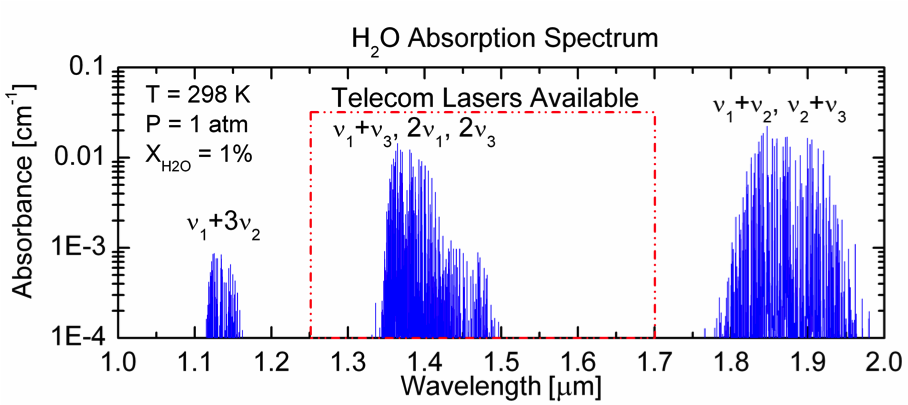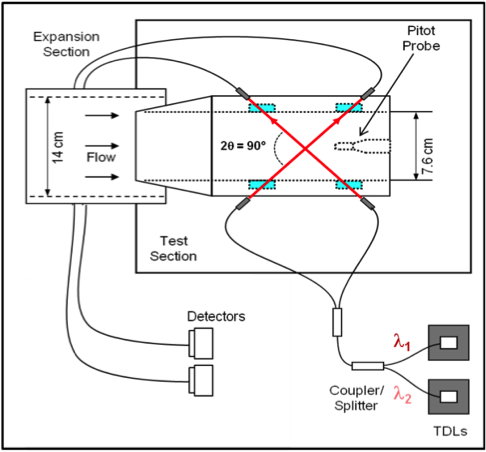| The Stanford Expansion Tube Flow Facility enables the study of supersonic combustion in flow-regimes characteristic of a scramjet combustor at flight Mach numbers of 4 to 9; however, the test conditions produced by this impulse facility are not easily predicted and are challenging to measure due to short test times and harsh conditions. Well-characterized test conditions provide an essential foundation for supersonic experimentation and serve as an anchor point for modeling of facility operation. |
| |
| |
| Overview |
| An H2O-based tunable diode laser absorption spectroscopy (TDLAS) diagnostic is under development to characterize transient phenomena within the Stanford Expansion Tube Flow Facility. TDLAS affords a robust, non-intrusive diagnostic technique suitable to the harsh environment of supersonic flows and capable of measuring key gas dynamic parameters including time-resolved temperature, H2O mole-fraction and flow velocity. |
| |

Fig. 1: H2O near-IR absorbance spectrum with illustration of transitions accessible by telecom diode lasers. |
| |
| The intrinsic presence of water within the test gas offers well-established rovibrational transitions (see Fig. 1) that are probed using scanned wavelength-modulation absorption spectroscopy with second harmonic detection (WMS-2f). The scanned-WMS-2f technique offers the bandwidth, sensitivity and noise resistance necessary for temperature and mole-fraction measurements to be performed within the harsh conditions of an expansion tube test section. Furthermore, by employing a crossed beam laser configuration (see Fig. 2), second harmonic Doppler shift velocimetry is performed in concert with the temperature and mole-fraction measurements to provide flow velocity data. |
| |

Fig. 2: Plan-view schematic of TDLAS velocimetry and thermometry diagnostic mounted inside Stanford Expansion Tube Flow Facility test section. |
| |
| The application of co-propagating thermometry and velocimetry in a supersonic impulse flow field demands numerous implementation and technique constraints that are not imposed in less dynamic test environments. To preserve the expansion section core flow and implement the optical components, a flow cutter model is employed (see Fig. 2) that incorporates wedged leading edges on a fully enclosed channel and includes extensive shielding to minimize optical component damage from diaphragm debris in the supersonic flow. Furthermore, the unique test environment and the goal of co-propagating thermometry and velocimetry dictate the use of non-ideal laser tuning in conjunction with the scanned-WMS-2f technique. This has led to the development of a new and rigorous scanned-WMS-2f theory that includes numerous non-ideal laser tuning effects unaccounted for in previous WMS-2f research. |
| |
| |
[an error occurred while processing this directive]


